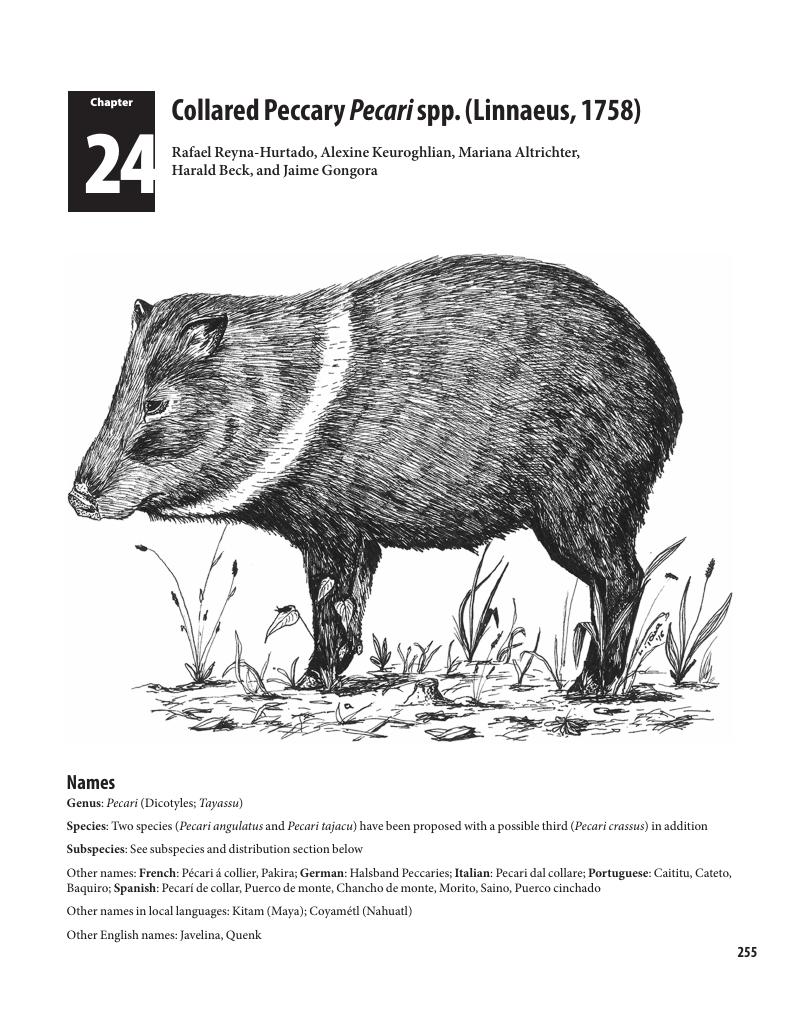Book contents
- Ecology, Conservation and Management of Wild Pigs and Peccaries
- Ecology, Conservation and Management of Wild Pigs and Peccaries
- Copyright page
- Dedication
- Contents
- Contributors
- Foreword
- Acknowledgements
- Introduction
- Part I Evolution, Taxonomy, and Domestication
- Part II Species Accounts
- 6 Sulawesi Babirusa Babyrousa celebensis (Deninger, 1909)
- 7 Moluccan Babirusa Babyrousa babyrussa (Linnaeus, 1758)
- 8 Togian Babirusa Babyrousa togeanensis (Sody, 1949)
- 9 Common Warthog Phacochoerus africanus (Gmelin, 1788)
- 10 Desert Warthog Phacochoerus aethiopicus (Pallas, 1766)
- 11 Forest Hog Hylochoerus meinertzhageni (Thomas 1904)
- 12 Bushpig Potamochoerus larvatus (F. Cuvier, 1822)
- 13 Red River Hog Potamochoerus porcus (Linnaeus, 1758)
- 14 Visayan Warty Pig Sus cebifrons (Heude, 1888)
- 15 Philippine Warty Pig Sus philippensis (Nehring, 1886)
- 16 Mindoro Warty Pig Sus oliveri (Groves, 1997)
- 17 Palawan Bearded Pig Sus ahoenobarbus (Huet, 1888)
- 18 Bearded Pig Sus barbatus (Müller, 1838)
- 19 Sulawesi Warty Pig Sus celebensis (Muller & Schlegel, 1843)
- 20 Javan Warty Pig Sus verrucosus (Boie, 1832) and Bawean Warty Pig Sus blouchi (Groves and Grubb, 2011)
- 21 Eurasian Wild Boar Sus scrofa (Linnaeus, 1758)
- 22 Pygmy Hog Porcula salvania (Hodgson, 1847)
- 23 Chacoan Peccary Catagonus wagneri (Rusconi, 1930)
- 24 Collared Peccary Pecari spp. (Linnaeus, 1758)
- 25 White-lipped Peccary Tayassu pecari (Link, 1795)
- Part III Conservation and Management
- Index
- References
24 - Collared Peccary Pecari spp. (Linnaeus, 1758)
from Part II - Species Accounts
Published online by Cambridge University Press: 21 November 2017
- Ecology, Conservation and Management of Wild Pigs and Peccaries
- Ecology, Conservation and Management of Wild Pigs and Peccaries
- Copyright page
- Dedication
- Contents
- Contributors
- Foreword
- Acknowledgements
- Introduction
- Part I Evolution, Taxonomy, and Domestication
- Part II Species Accounts
- 6 Sulawesi Babirusa Babyrousa celebensis (Deninger, 1909)
- 7 Moluccan Babirusa Babyrousa babyrussa (Linnaeus, 1758)
- 8 Togian Babirusa Babyrousa togeanensis (Sody, 1949)
- 9 Common Warthog Phacochoerus africanus (Gmelin, 1788)
- 10 Desert Warthog Phacochoerus aethiopicus (Pallas, 1766)
- 11 Forest Hog Hylochoerus meinertzhageni (Thomas 1904)
- 12 Bushpig Potamochoerus larvatus (F. Cuvier, 1822)
- 13 Red River Hog Potamochoerus porcus (Linnaeus, 1758)
- 14 Visayan Warty Pig Sus cebifrons (Heude, 1888)
- 15 Philippine Warty Pig Sus philippensis (Nehring, 1886)
- 16 Mindoro Warty Pig Sus oliveri (Groves, 1997)
- 17 Palawan Bearded Pig Sus ahoenobarbus (Huet, 1888)
- 18 Bearded Pig Sus barbatus (Müller, 1838)
- 19 Sulawesi Warty Pig Sus celebensis (Muller & Schlegel, 1843)
- 20 Javan Warty Pig Sus verrucosus (Boie, 1832) and Bawean Warty Pig Sus blouchi (Groves and Grubb, 2011)
- 21 Eurasian Wild Boar Sus scrofa (Linnaeus, 1758)
- 22 Pygmy Hog Porcula salvania (Hodgson, 1847)
- 23 Chacoan Peccary Catagonus wagneri (Rusconi, 1930)
- 24 Collared Peccary Pecari spp. (Linnaeus, 1758)
- 25 White-lipped Peccary Tayassu pecari (Link, 1795)
- Part III Conservation and Management
- Index
- References
Summary

- Type
- Chapter
- Information
- Ecology, Conservation and Management of Wild Pigs and Peccaries , pp. 255 - 264Publisher: Cambridge University PressPrint publication year: 2017
References
- 2
- Cited by

